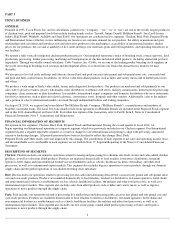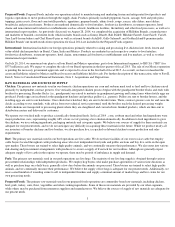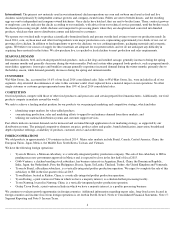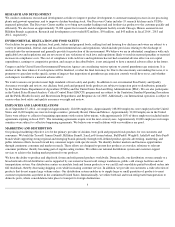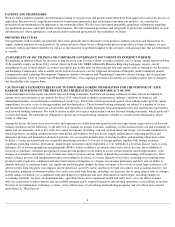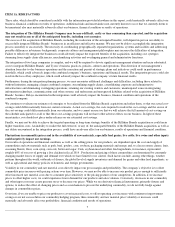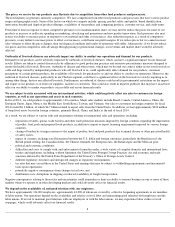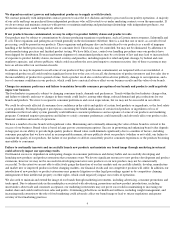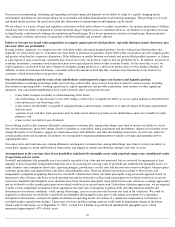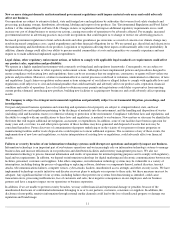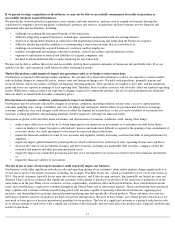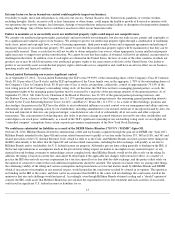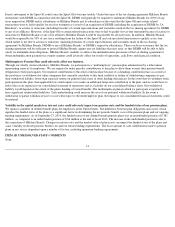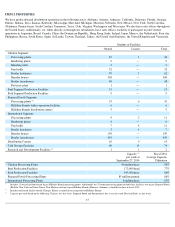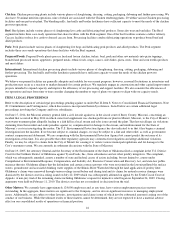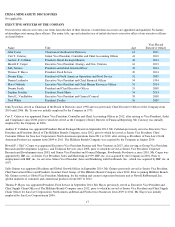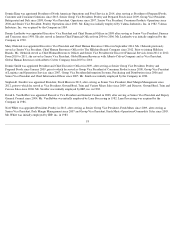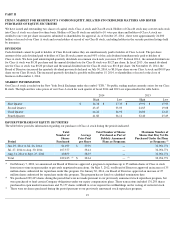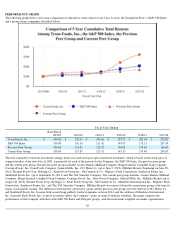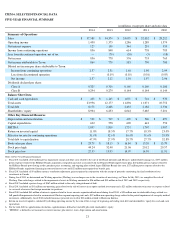Tyson Foods 2014 Annual Report Download - page 14
Download and view the complete annual report
Please find page 14 of the 2014 Tyson Foods annual report below. You can navigate through the pages in the report by either clicking on the pages listed below, or by using the keyword search tool below to find specific information within the annual report.
If we pursue strategic acquisitions or divestitures, we may not be able to successfully consummate favorable transactions or
successfully integrate acquired businesses.
We periodically evaluate potential acquisitions, joint ventures and other initiatives, and may seek to expand our business through the
acquisition of companies, processing plants, technologies, products and services. Acquisitions and joint ventures involve financial and
operational risks and uncertainties, including:
We may not be able to address these risks and successfully develop these acquired companies or businesses into profitable units. If we are
unable to do this, such expansion could adversely affect our financial results.
Market fluctuations could negatively impact our operating results as we hedge certain transactions.
Our business is exposed to fluctuating market conditions. We use derivative financial instruments to reduce our exposure to various market
risks including changes in commodity prices, interest rates and foreign exchange rates. We hold certain positions, primarily in grain and
livestock futures, that do not qualify as hedges for financial reporting purposes. These positions are marked to fair value, and the unrealized
gains and losses are reported in earnings at each reporting date. Therefore, losses on these contracts will adversely affect our reported operating
results. While these contracts reduce our exposure to changes in prices for commodity products, the use of such instruments may ultimately
limit our ability to benefit from favorable commodity prices.
Deterioration of economic conditions could negatively impact our business.
Our business may be adversely affected by changes in economic conditions, including inflation, interest rates, access to capital markets,
consumer spending rates, energy availability and costs (including fuel surcharges) and the effects of governmental initiatives to manage
economic conditions. Any such changes could adversely affect the demand for our products, or the cost and availability of our needed raw
materials, cooking ingredients and packaging materials, thereby negatively affecting our financial results.
Disruptions in global credit and other financial markets and deterioration of economic conditions could, among other things:
The loss of one or more of our largest customers could negatively impact our business.
Our business could suffer significant setbacks in sales and operating income if our customers’ plans and/or markets change significantly or if
we lost one or more of our largest customers, including, for example, Wal-Mart Stores, Inc., which accounted for 14.6% of our sales in fiscal
2014 . Our retail customers typically do not enter into written contracts, and if they do sign contracts, they generally are limited in scope and
duration. There can be no assurance that significant customers will continue to purchase our products in the same mix or quantities or on the
same terms as in the past. Many of our customers, such as supermarkets, warehouse clubs and food distributors, have consolidated in recent
years, and consolidation is expected to continue throughout the United States and in other major markets. These consolidations have produced
large, sophisticated customers with increased buying power who are more capable of operating with reduced inventories, opposing price
increases, and demanding lower pricing, increased promotional programs and specifically tailored products. These customers also may use
shelf space currently used for our products for their own private label products. Because of these trends, our volume growth could slow or we
may need to lower prices or increase promotional spending for our products. The loss of a significant customer or a material reduction in sales
to, or adverse change to trade terms with, a significant customer could materially and adversely affect our product sales, financial condition and
results of operations.
12
•
challenges in realizing the anticipated benefits of the transaction;
•
difficulty integrating acquired businesses, technologies, operations and personnel with our existing business;
•
diversion of management attention in connection with negotiating transactions and integrating the businesses acquired;
•
difficulty identifying suitable candidates or consummating a transaction on terms that are favorable to us;
•
challenges in retaining the acquired businesses' customers and key employees;
•
inability to implement and maintain consistent standards, controls, procedures and information systems;
•
exposure to unforeseen or undisclosed liabilities of acquired companies; and
•
the need to obtain additional debt or equity financing for any transaction.
•
make it more difficult or costly for us to obtain financing for our operations or investments or to refinance our debt in the future;
•
cause our lenders to depart from prior credit industry practice and make more difficult or expensive the granting of any amendment of,
or waivers under, our credit agreements to the extent we may seek them in the future;
• impair the financial condition of some of our customers and suppliers, thereby increasing customer bad debts or non-performance by
suppliers;
•
negatively impact global demand for protein products, which could result in a reduction of sales, operating income and cash flows;
• decrease the value of our investments in equity and debt securities, including our marketable debt securities, company-owned life
insurance and pension and other postretirement plan assets;
• negatively impact our commodity purchasing activities if we are required to record losses related to derivative financial instruments;
or
•
impair the financial viability of our insurers.


